Ptosis Surgery For Droopy Eyelids
Droopy Eyelids
Upper eyelid ptosis is the abnormal heaviness of the upper eyelids. Some people call this a droopy or a lazy eyelid. You can be born with this condition or it can develop at any time in life. In some cases, upper eyelid ptosis may signal a medical illness and be the presenting symptom of certain rare systemic diseases. However, for most, ptosis develops gradually and almost imperceptibly. Then it happens. You notice it in a photo, or someone mentions it in passing that you look tired. Unfortunately, as a society, we associate individuals with heavy upper eyelids as sleepy, lazy, and shiftless. Managers think individuals with heavy upper eyelids are unmotivated. Women with heavy upper eyelids are said to have “bedroom” eyes. Ask yourself how seriously your colleagues will take you if you have bedroom eyes? The asymmetry between the two upper eyelids often calls attention to the issue. In addition, there is often a compensatory elevation of the eyebrow. When the upper eyelids are heavy on the eyes, the brain sends a signal to the muscle in the forehead to contract. This combination of the heavy upper eyelid and raised forehead is very common. The compensatory eyebrow elevation can also be asymmetric.
At some point, you decided that you have to do something about these eyelids. Please understand that Botox and eye fillers are not an option for addressing these heavy upper eyelids. Well-meaning doctors may offer these services as non-surgical treatments but they are unsatisfactory. The internet offers drops to lift the upper eyelid. Drops like Visine do contain medication that stimulates the superior tarsal muscle, also called the Müller’s muscle. The active ingredient in this product is called tetrahydrozoline hydrochloride. Don’t get too excited. The drop only lasts for about an hour and does not work for everyone. Using it more than twice a day will cause eye irritation. It is not a practical alternative to having ptosis surgery to fix a droopy eyelid.
Before & Afters
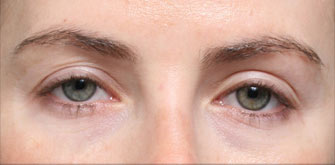
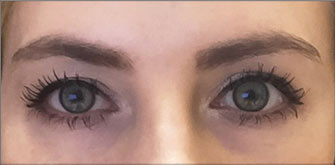
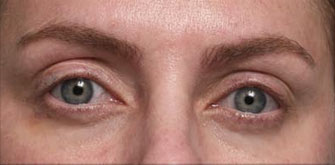
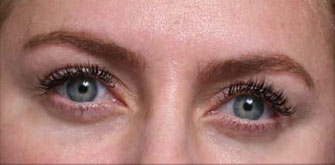
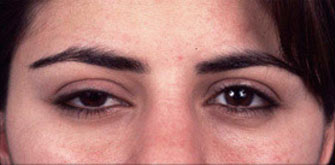

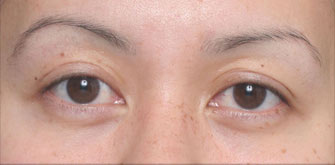
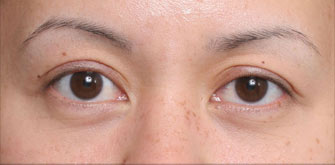
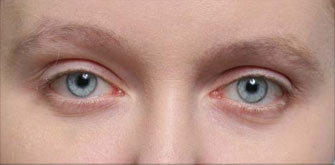
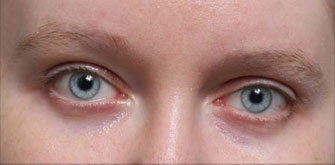
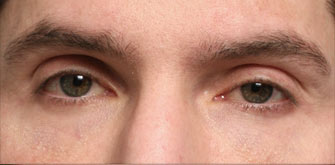
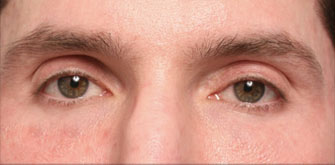
It is natural to ask if your health insurance will cover your heavy upper eyelid. When the eyelid is heavy enough, many health insurance carriers will cover this service. However, what is required is that the eyelid actually blocks the vision. That is a pretty heavy eyelid. Most people need surgery to fix an upper eyelid as soon as they notice the issue and really can’t wait until the eyelid is so bad that it actually blocks vision. That means that one will get the eyelid fixed when most insurance companies consider the problem a cosmetic issue rather than a functional problem.
If you have gone online to read about ptosis surgery, it can be confusing. First, it is critical to understand that there are multiple causes for upper eyelid ptosis. As noted above, in rare cases, there can be an underlying medical condition that can be associated with upper eyelid ptosis. You need to see an oculoplastic surgeon like Dr. Steinsapir who can assess you for those issues if appropriate, but they are rare. You may read about congenital ptosis. This is not a single type of ptosis but a range of issues. What unifies them is that the heavy upper eyelid was present at birth. If you have the most severe form of congenital ptosis, you will know it because these are surgically treated in infancy. The most challenging form of congenital ptosis arises from a lack of normal development of the muscle that opens the upper eyelid. That muscle is called the levator palpebrae superioris muscle. When it does not develop normally, the upper eyelid blocks the affected eye, a vision-threatening condition in a newborn. This mechanical coverage of the eye from the heavy eyelid will affect the neurologic development of the visual pathways leading to a condition called amblyopia. That can result in a life long impairment of vision and for this reason, treatment is immediately applied to address the situation. This usually involves a frontalis sling surgery to help open the eye and patching therapy to treat the amblyopia. This is only an issue for newborns and infants. As we mature and the visual system is fully developed, a droopy eyelid does not pose this type of concern. There can be long-term issues with the eyelids that necessitate revisional eyelid surgery as an adult. It is important to understand that in the absence of a normally developed levator palpebrae superioris muscle, options for making these eyelids look and function like a normal upper eyelid are somewhat limited.
It is worth stressing that unless you have a history of eyelid surgery with a frontalis sling early in life, it is highly unlike that this is the basis for your droopy upper eyelid. It is far more common to have a childhood history of mild upper eyelid ptosis or upper eyelid asymmetry that never required upper eyelid ptosis surgery. These are often left unaddressed surgically because the issue is small enough and never occurred to your parents to have you assessed for this issue. As an adult, you may have other ideas about what is or is not a problem. When we study childhood pictures of individuals with a long history of mild upper eyelid ptosis, it is clear that one or both eyelids were always a bit heavy. Not so heavy though as to be a functional problem. This is still considered a type of congenital ptosis just not a severe form of congenital ptosis. In these eyelids, the levator palpebrae superioris muscle is developed. There may be a formed upper eyelid crease or it may be absent due to a lack of an attachment between the upper eyelid skin and the underlying levator aponeurosis tendon, the tendon of the levator palpebrae superioris muscle. Ptosis surgery can be performed to make these eyes more open an also defines an upper eyelid crease. The goal is symmetry between the eyelids with a natural upper eyelid height, contour, and crease.
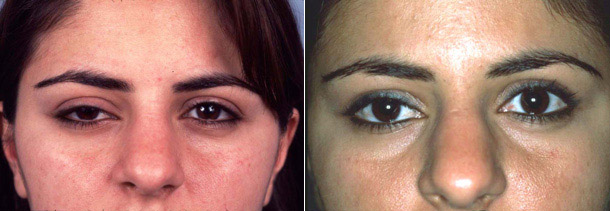
Eyelid plastic surgeons favor the use of a surgery called the Müller’s muscle conjunctival resection ptosis (MMCR) surgery. Eighty percent of oculoplastic surgeons favor this surgery. It is a very predictable and technically straightforward means of performing ptosis surgery. When it works, it is a very nice method of fixing ptosis. The problem is that it is an inappropriate surgery for many eyelids. Yet surgeons will choose this approach even when it is not right. The field seems to be willing to tolerate a 30% failure rate for this surgery. You may have even been told not to repair your upper eyelid ptosis. The surgeon is generally telling you that with their surgery, they cannot repair the small amount of upper eyelid ptosis with sufficient accuracy and reliability to state with certainty that you will have a benefit. The question is why? The problem is that if the surgeon raises the eyelid 1 mm, you are likely to regard surgery as unsuccessful if you really needed the eyelid raised 2 mm: Your eyelid will still look heavy.
Recent anatomic studies about how the MMCR surgery works make it clear that the surgery works by pinching the tendon inside the eyelid. Scar tissue formed as the eyelid heals after surgery, makes this pinch permanent. The problem is that if the tendon is not in a favorable position it cannot be sufficiently strengthened by the MMCR. If the surgeon knows what to look for, disinsertion of the tendon can be determined at the time of your personal consultation if it is looked for and a different surgical approach should be determined.
Dr. Steinsapir is very aware of the limitations of the MMCR. For that reason, he, more often than not, recommends a different type of ptosis surgery. When it is clear that the levator aponeurosis tendon is disinserted, which is all too common, he will recommend an anterior levator resection ptosis surgery. This is done through a crease incision. This creates the opportunity to change the height of the upper eyelid crease. Generally, it is best to lower the upper eyelid crease. In men, the upper eyelid crease should be relatively low 6.5 to 8 mm. Women also benefit from a lower crease that is well defined. All too commonly after eyelid surgery, the crease can settle in at 10 to 12 mm and this is much too high. At that height, the high upper eyelid crease tends to make the upper eyelid look hollow and depleted. Lifting the eyelid with the anterior levator resection ptosis surgery opens the eye and keeps the crease height at a natural location. The anterior levator is a much more flexible surgery than the MMCR. The anterior levator resection ptosis surgery is good for fixing both very small amounts or very large amounts of ptosis The position of the upper eyelid and the effect of surgery can be monitored during surgery making it much more likely to accomplish the surgical goals.
The anterior levator approach through an upper eyelid crease lowering approach also permits the performance of blepharoplasty. This is a surgical detail that is a bit of a lost art. Dr. Steinsapir routinely performs anchor blepharoplasty where appropriate. An anchor blepharoplasty is the formation of a well-defined upper eyelid crease, which is a connective tissue attachment between the lower edge of the anterior levator aponeurosis, the tendon of the levator palpebrae superioris muscle and the upper eyelid platform skin and underlying orbicularis oculi muscle. By precisely engineering the placement of the upper eyelid crease and the cut edge of the levator aponeurosis tendon the eyelid platform skin is snugged to the upper eyelid crease. This smoothes the upper eyelid platform skin like one might snug a bed-sheet. This makes for a clean platform for holding makeup. Also, the tighten eyelid platform skin supports the upper eyelid lashes allowing them to be perky.
Where will your surgery be performed?
Dr. Steinsapir performs his surgery in two locations. For most patients, he performs surgery in the private, state of the art, accredited surgery center in the operating rooms that are part of his beautiful Beverly Hills Office. The other location he performs surgery is the Surgery Center at the UCLA Ronald Regan Medical Center on the UCLA Campus. Generally, this center is used for patients who want cosmetic surgery but have more significant health issues. For others, they love the affordability and convenience of the surgery center in Dr. Steinsapir’s office. Not every surgeon has her/his own accredited surgery center and operating room. A surgeon may pressure you to have your eyelid surgery under just local anesthetic in an unaccredited procedure room. That may not be right for you. Most patients benefit from some degree of sedation, even if brief, to make surgery comfortable. When sedation is not available, you will be more aware of the work that is being performed and the injection of local anesthetic. Most can tolerate this discomfort, but it is so much more pleasant to be properly sedated. Your comfort and safety is our foremost concern. In addition, the certification of the surgery center assures you that appropriate quality assurance standards are met in all aspects of your surgical care. Dr. Steinsapir is very proud of the quality standards met by his office and surgery center. Ask for a tour when you are in the office. There are very few centers that are as clean and modern as Dr. Steinsapir’s office and plastic surgery center.
Ptosis Surgery Beverly Hills & Los Angeles
Dr. Steinsapir and his staff will also discuss with you prior to surgery what you need for your recovery. This is very important. For those who are coming from out of town, they may need a night nurse for one or two nights or in some cases, a recovery facility may be recommended. For those traveling with loved ones, in most cases, your family member can serve as your night nurse. For individuals who live in the area, they have the option of recovering at home, but in some cases, it may make sense to stay within a short distance of the office for the first night or two. These are details that will be discussed with you based on your circumstances and the exact nature of the surgery that is planned.
Your eyelid surgery can serve as a key stepping stone along the path to become the best possible version of yourself, and you can take the first step by calling to schedule your personal consultation with Dr. Steinsapir today.
Dr. Steinsapir is a UCLA and University of Chicago-trained eyelid surgeon and founder of Lid Lift, Beverly Hills. Visit the homepage to see how cosmetic eyelid surgery can help you achieve your aesthetic goals.
